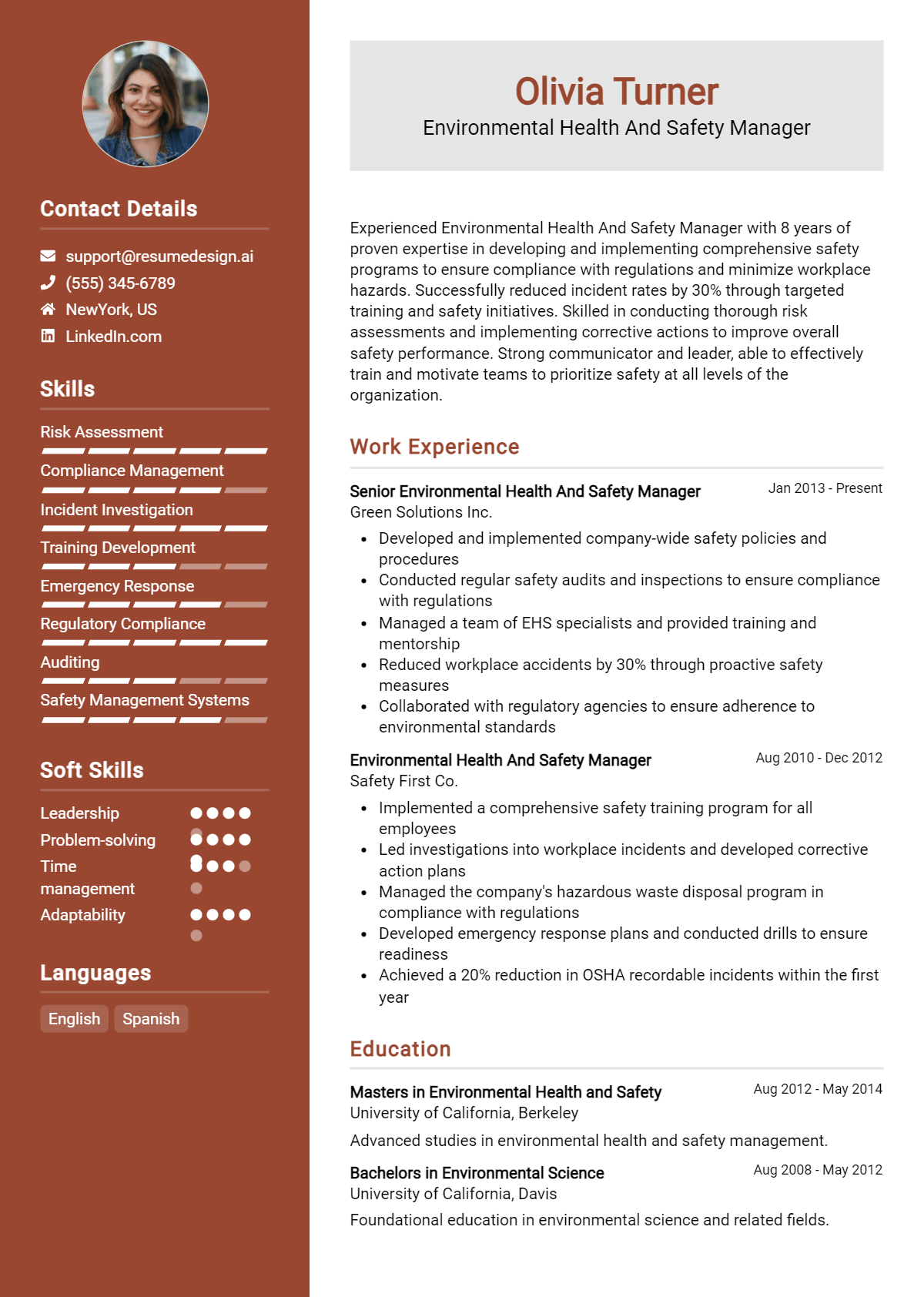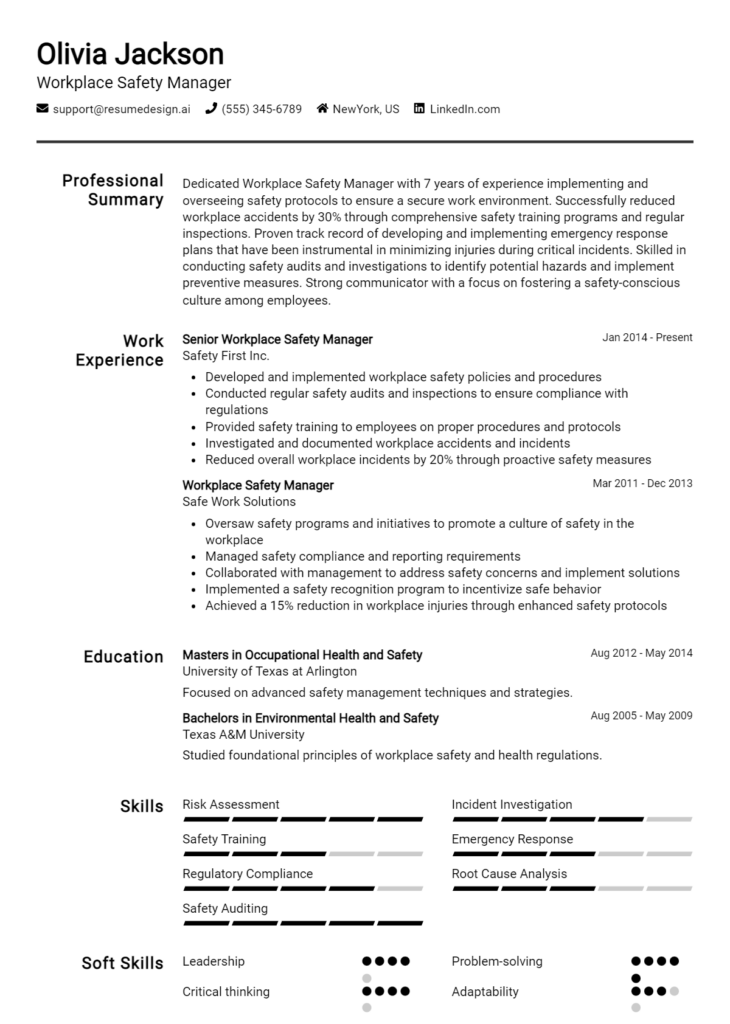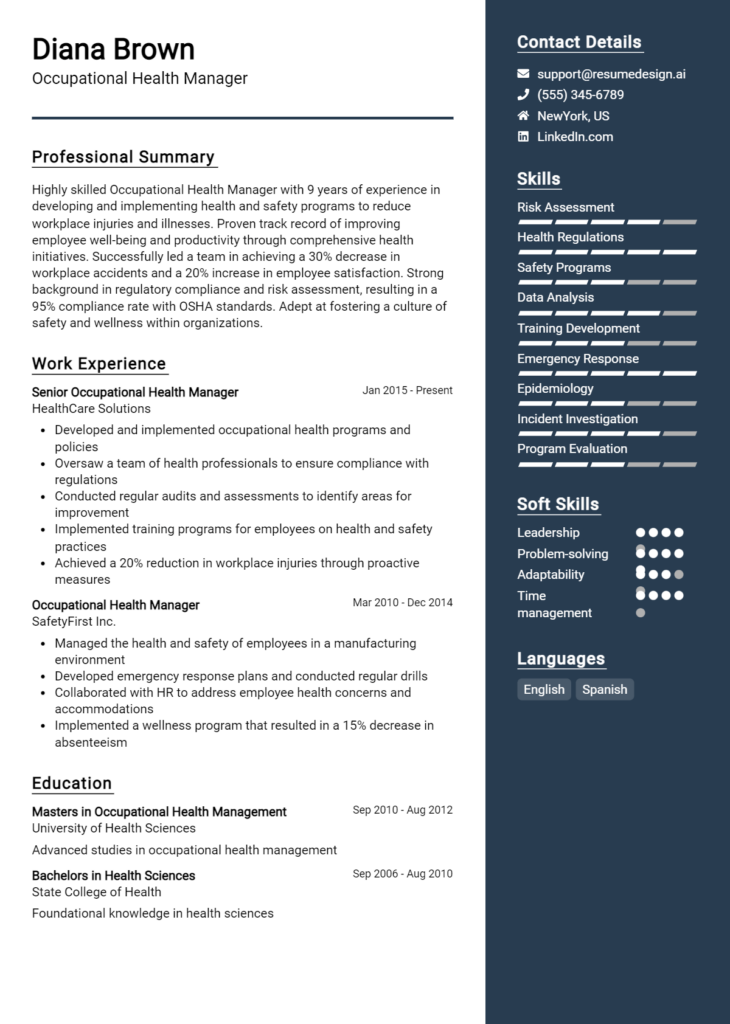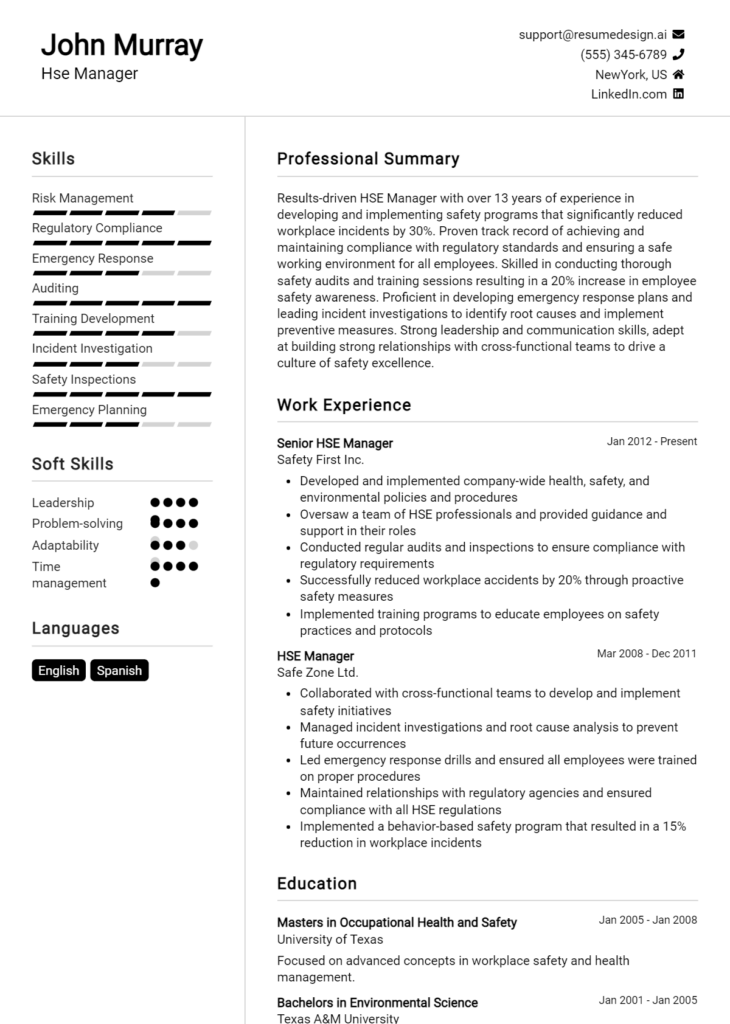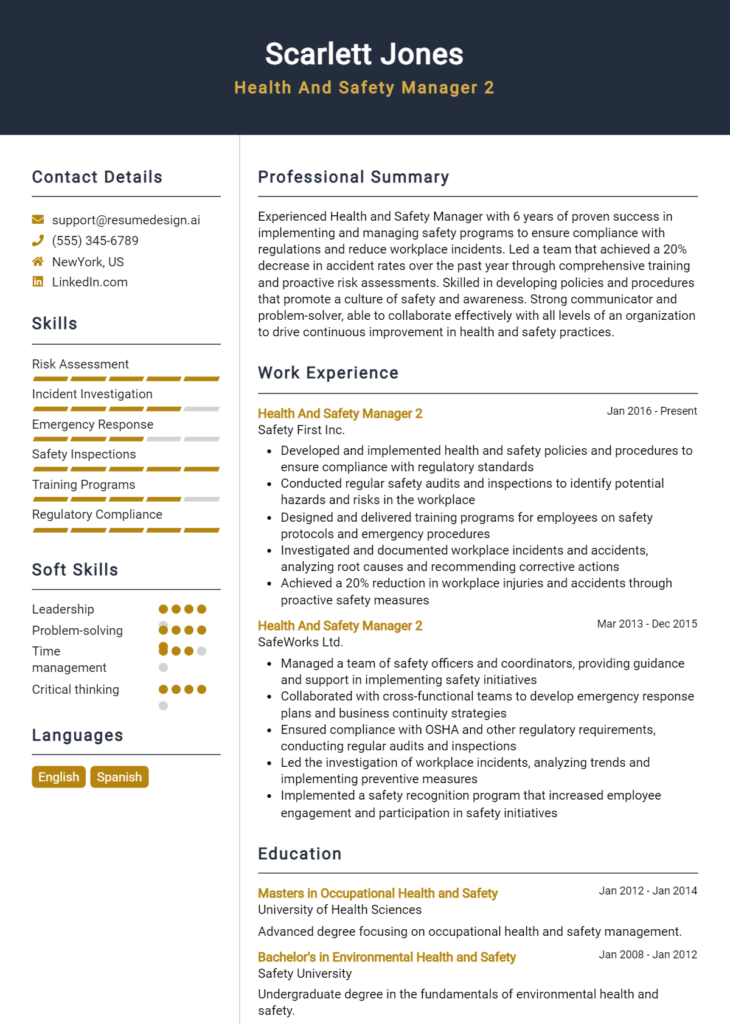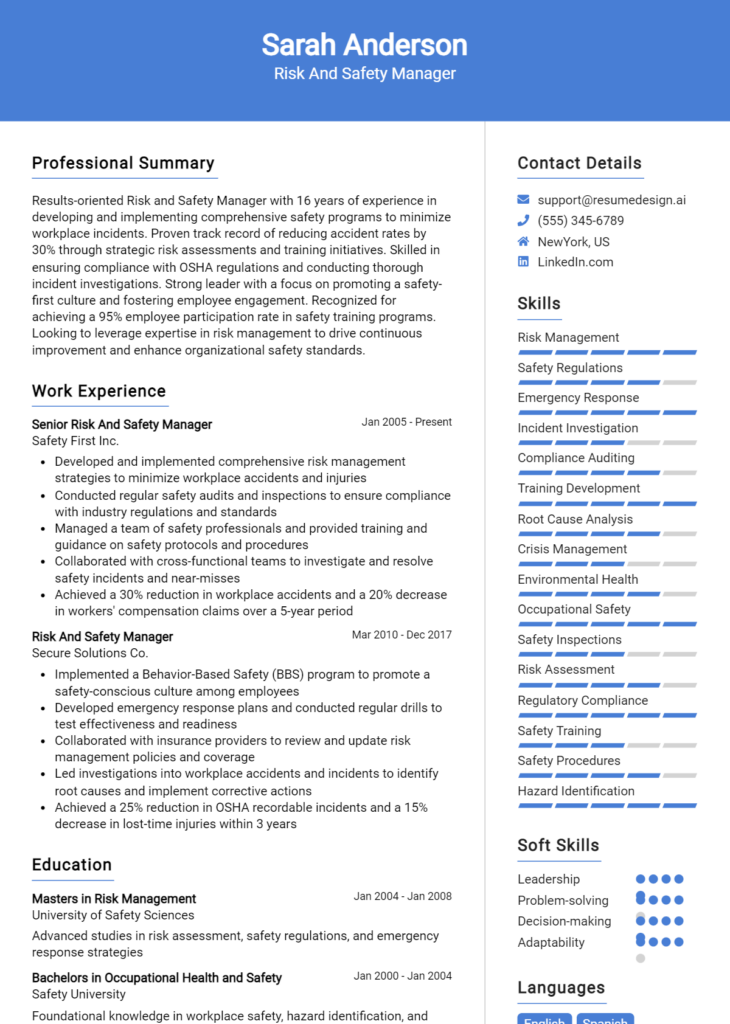Environmental Health and Safety Manager Core Responsibilities
An Environmental Health and Safety Manager plays a crucial role in ensuring workplace safety and compliance with environmental regulations. This professional is responsible for developing, implementing, and monitoring safety policies while collaborating with various departments such as operations, human resources, and legal. Key skills include technical knowledge of safety regulations, operational oversight, and strong problem-solving abilities. These competencies contribute significantly to an organization’s overall goals by minimizing risks and enhancing operational efficiency. A well-structured resume is vital in effectively showcasing these qualifications to potential employers.
Common Responsibilities Listed on Environmental Health and Safety Manager Resume
- Develop and implement safety policies and procedures.
- Conduct regular safety audits and risk assessments.
- Lead training programs on safety practices for employees.
- Ensure compliance with environmental regulations and standards.
- Investigate accidents and incidents to identify root causes.
- Collaborate with management to promote a culture of safety.
- Monitor and report on safety performance metrics.
- Maintain safety documentation and records.
- Coordinate emergency response plans and drills.
- Stay updated on industry regulations and best practices.
- Advise on the selection and use of personal protective equipment (PPE).
- Engage with external regulatory agencies during inspections.
High-Level Resume Tips for Environmental Health and Safety Manager Professionals
In the competitive field of Environmental Health and Safety Management, a well-crafted resume is crucial for making a strong first impression on potential employers. Your resume serves as your initial introduction, showcasing your skills, experiences, and achievements in a way that captures the attention of hiring managers. It is essential to present not just what you have done, but how your contributions have made a difference in previous roles. This guide will provide practical and actionable resume tips specifically tailored for Environmental Health and Safety Manager professionals, ensuring that your application stands out in a crowded job market.
Top Resume Tips for Environmental Health and Safety Manager Professionals
- Tailor your resume to match the job description, highlighting relevant experiences and skills that align with the specific requirements of the position.
- Start with a strong summary statement that encapsulates your expertise in environmental health and safety management, focusing on your years of experience and key accomplishments.
- Showcase relevant certifications, such as OSHA training, ISO certifications, or any specialized training that enhances your qualifications.
- Quantify your achievements by including metrics, such as reductions in workplace incidents, improvements in compliance rates, or cost savings from safety initiatives.
- Highlight your ability to conduct risk assessments and develop safety policies, emphasizing your proactive approach to preventing workplace hazards.
- Include specific software or tools you are proficient in, such as environmental management systems or incident reporting software, to demonstrate your technical skills.
- Use action verbs to describe your responsibilities and achievements, making your contributions clear and impactful.
- Incorporate keywords from the job posting to optimize your resume for Applicant Tracking Systems (ATS) and increase your visibility to employers.
- Keep your resume concise and focused, ideally one to two pages, ensuring that every section adds value to your candidacy.
By implementing these tips, you can significantly enhance your resume and increase your chances of landing a job in the Environmental Health and Safety Manager field. A well-structured and targeted resume not only showcases your qualifications but also demonstrates your commitment to excellence in this important area of workplace safety and environmental stewardship.
Why Resume Headlines & Titles are Important for Environmental Health and Safety Manager
In the competitive field of Environmental Health and Safety (EHS) management, a well-crafted resume headline or title is essential for standing out to hiring managers. This brief yet powerful phrase serves as the first impression of a candidate’s qualifications, summarizing key skills and experiences in a manner that immediately captures attention. A strong headline not only conveys relevance to the specific job being applied for but also reflects the candidate’s unique value proposition, making it crucial for setting the tone of the resume. It should be concise, impactful, and tailored to resonate with the specific requirements of the EHS role.
Best Practices for Crafting Resume Headlines for Environmental Health and Safety Manager
- Keep it concise: Aim for a headline that is no longer than 10 words.
- Be role-specific: Use keywords that align with the Environmental Health and Safety industry.
- Highlight key qualifications: Focus on your most relevant skills or achievements.
- Use action verbs: Start with strong verbs that convey proactive behavior.
- Incorporate measurable outcomes: If applicable, include quantifiable results from previous roles.
- Tailor for each application: Customize your headline to reflect the specific job description.
- Avoid jargon: Use clear language that can be easily understood by a wide audience.
- Make it memorable: Use strong words that leave a lasting impression on the reader.
Example Resume Headlines for Environmental Health and Safety Manager
Strong Resume Headlines
"Certified EHS Manager with 10 Years of Proven Safety Leadership"
“Proficient in Risk Management and Compliance with 95% Incident Reduction”
“Dynamic EHS Professional Specializing in Sustainable Practices”
Weak Resume Headlines
“Experienced Manager”
“Seeking Job in Environmental Health and Safety”
Strong resume headlines are effective because they clearly communicate the candidate’s expertise and value in a specific context, allowing hiring managers to quickly assess their fit for the role. By being precise and impactful, these headlines create a compelling narrative that encourages further exploration of the resume. In contrast, weak headlines fall short as they lack specificity and relevance, making it difficult for hiring managers to gauge the candidate's qualifications or interest in the position. As a result, these generic titles often fail to engage the reader and can lead to missed opportunities.
Writing an Exceptional Environmental Health and Safety Manager Resume Summary
A well-crafted resume summary is essential for an Environmental Health and Safety Manager, as it serves as a powerful introduction to your qualifications and career achievements. This brief yet impactful section is designed to grab the attention of hiring managers, effectively showcasing your key skills, relevant experience, and notable accomplishments in the field of environmental health and safety. A strong summary should be concise, engaging, and tailored specifically to the job you are applying for, ensuring that it aligns with the organization's needs and expectations.
Best Practices for Writing a Environmental Health and Safety Manager Resume Summary
- Quantify Achievements: Include specific metrics or results that demonstrate your impact in previous roles.
- Focus on Skills: Highlight key skills relevant to environmental health and safety, such as regulatory compliance, risk assessment, and training.
- Tailor the Summary: Customize your summary for each job application, aligning it with the job description and company values.
- Be Concise: Keep your summary brief, ideally 3-5 sentences, to maintain the reader’s attention.
- Use Strong Action Verbs: Begin sentences with impactful verbs to convey a sense of proactivity and leadership.
- Highlight Certifications: Mention relevant certifications or training that bolster your credentials in the field.
- Showcase Industry Knowledge: Include specific knowledge of industry standards and regulations that pertain to the position.
- Communicate Passion: Convey your enthusiasm for environmental health and safety to demonstrate your commitment to the field.
Example Environmental Health and Safety Manager Resume Summaries
Strong Resume Summaries
Dynamic Environmental Health and Safety Manager with over 10 years of experience in implementing comprehensive safety programs resulting in a 40% reduction in workplace incidents. Proven track record in regulatory compliance and fostering a culture of safety across diverse teams.
Results-driven EHS professional with expertise in environmental audits and risk assessments, successfully reducing hazardous waste by 30% while ensuring full compliance with EPA regulations. Adept at conducting training sessions that increased employee awareness and engagement by 25%.
Highly skilled Environmental Health and Safety Manager with a strong background in developing safety protocols that improved incident reporting accuracy by 50%. Passionate about sustainability initiatives, leading projects that resulted in a 20% decrease in carbon footprint across manufacturing operations.
Weak Resume Summaries
Experienced manager with a background in safety and health. Worked on various projects and have some knowledge of regulations.
Environmental Health and Safety Manager looking for a new opportunity. Committed to safety and compliance in the workplace.
The strong resume summaries are effective because they clearly articulate measurable achievements, present relevant skills, and demonstrate a strong alignment with the role's requirements. They use specific data to substantiate claims, making them credible and compelling. In contrast, the weak summaries lack detail, present vague information, and do not quantify any results, making them less engaging and informative for hiring managers.
Work Experience Section for Environmental Health and Safety Manager Resume
The work experience section of an Environmental Health and Safety Manager resume is a critical component that highlights the candidate's technical skills and ability to manage teams effectively. This section provides a platform to showcase not only the individual’s expertise in environmental regulations, safety protocols, and risk management but also their capacity to deliver high-quality products and services. By quantifying achievements and aligning experiences with industry standards, candidates can demonstrate their value to potential employers, making it clear how they can contribute to the organization's health and safety objectives.
Best Practices for Environmental Health and Safety Manager Work Experience
- Utilize action verbs to describe responsibilities and achievements clearly.
- Quantify results with specific metrics, such as percentage reductions in incidents or compliance improvements.
- Highlight technical certifications and relevant training to establish credibility.
- Showcase collaborative projects that demonstrate teamwork with other departments.
- Focus on outcomes that align with industry standards and best practices.
- Incorporate specific examples of regulatory compliance and safety program implementation.
- Tailor descriptions to match the job description and requirements of the position being applied for.
- Use bullet points for clarity and conciseness, making it easy for hiring managers to read.
Example Work Experiences for Environmental Health and Safety Manager
Strong Experiences
- Developed and implemented a new safety training program that reduced workplace accidents by 30% within the first year.
- Led a cross-functional team in achieving ISO 14001 certification, enhancing the organization’s environmental management systems and reducing waste by 25%.
- Managed a budget of $500,000 for safety initiatives, successfully reallocating resources that resulted in a 15% increase in compliance with OSHA regulations.
- Conducted comprehensive risk assessments that identified critical hazards, leading to the implementation of new safety protocols and a 40% decrease in near-miss incidents.
Weak Experiences
- Responsible for ensuring safety regulations were followed.
- Worked on safety programs and occasionally participated in meetings.
- Assisted in training new employees on safety procedures.
- Helped with compliance issues when needed.
The examples provided highlight the distinction between strong and weak experiences. Strong experiences are characterized by quantifiable outcomes, clear leadership roles, and collaboration, showcasing the candidate's impact on safety and environmental initiatives. In contrast, weak experiences lack specificity and measurable results, failing to convey the candidate's skills and contributions effectively. By emphasizing achievements and technical expertise, candidates can create a compelling narrative that resonates with potential employers.
Education and Certifications Section for Environmental Health and Safety Manager Resume
The education and certifications section of an Environmental Health and Safety Manager resume is crucial as it serves as a testament to the candidate's academic background and professional preparedness. This section not only showcases the degrees earned but also highlights industry-relevant certifications and ongoing learning efforts that are essential in the ever-evolving field of environmental health and safety. By providing relevant coursework, specialized training, and recognized credentials, candidates can greatly enhance their credibility and demonstrate their commitment to aligning with industry standards and expectations, thus making a strong impression on potential employers.
Best Practices for Environmental Health and Safety Manager Education and Certifications
- Include degrees in relevant fields such as Environmental Science, Occupational Health, or Safety Management.
- Highlight industry-recognized certifications such as Certified Safety Professional (CSP) or Certified Industrial Hygienist (CIH).
- List any specialized training programs or workshops completed that pertain to environmental regulations or safety protocols.
- Provide details of relevant coursework that demonstrates a thorough understanding of key concepts in environmental health and safety.
- Ensure that certifications are current and indicate the renewal dates to show ongoing professional development.
- Consider including any memberships in professional organizations related to environmental health and safety.
- Be specific about the level of education achieved, such as Bachelor's, Master's, or Doctorate, to establish expertise.
- Use bullet points for clarity and easy readability, allowing hiring managers to quickly grasp qualifications.
Example Education and Certifications for Environmental Health and Safety Manager
Strong Examples
- Bachelor of Science in Environmental Science, University of California, 2015
- Certified Safety Professional (CSP), Board of Certified Safety Professionals, 2021
- Master of Public Health (MPH) with a concentration in Occupational Safety, Harvard University, 2018
- Hazardous Waste Operations and Emergency Response (HAZWOPER) Certification, 2022
Weak Examples
- Associate Degree in General Studies, Community College, 2010
- Certification in Basic First Aid (expired in 2020)
- High School Diploma, 2005
- Outdated OSHA 10-Hour Training Certification, 2015
The strong examples are considered effective because they showcase relevant degrees and certifications that are directly applicable to the Environmental Health and Safety Manager role, demonstrating a strong foundation and commitment to professional growth. In contrast, the weak examples reflect qualifications that lack relevance to the position, are outdated, or do not provide any substantial evidence of expertise in the field, which could detract from the candidate's overall appeal to potential employers.
Top Skills & Keywords for Environmental Health and Safety Manager Resume
As an Environmental Health and Safety (EHS) Manager, possessing a robust set of skills is crucial for ensuring the well-being of employees and compliance with regulatory standards. The effectiveness of an EHS Manager largely hinges on their ability to navigate complex safety protocols, foster a culture of safety within the organization, and respond adeptly to emergencies. A well-crafted resume that highlights both hard and soft skills can significantly enhance job prospects and demonstrate a commitment to creating safer work environments. By showcasing relevant skills and impactful work experience, candidates can effectively communicate their qualifications and readiness for the role.
Top Hard & Soft Skills for Environmental Health and Safety Manager
Soft Skills
- Strong communication abilities
- Leadership and team management
- Problem-solving aptitude
- Attention to detail
- Adaptability and flexibility
- Conflict resolution skills
- Analytical thinking
- Time management
- Interpersonal skills
- Training and mentoring capabilities
Hard Skills
- Knowledge of OSHA regulations
- Risk assessment and management
- Incident investigation techniques
- Environmental regulations compliance
- Safety program development
- Emergency response planning
- Data analysis and reporting
- Auditing and inspection skills
- Familiarity with safety equipment
- Proficiency in safety management software
- Project management skills
- Policy development and implementation
- Environmental impact assessments
- Training program design and execution
- Knowledge of industrial hygiene practices
- First aid and CPR certification
- Regulatory reporting and documentation
Stand Out with a Winning Environmental Health and Safety Manager Cover Letter
I am writing to express my interest in the Environmental Health and Safety (EHS) Manager position at [Company Name], as advertised on [where you found the job listing]. With over [X years] of experience in the EHS field, I am confident in my ability to contribute effectively to your organization and ensure compliance with environmental regulations while promoting a culture of safety within the workplace. My background in developing and implementing comprehensive EHS programs aligns perfectly with your company’s commitment to sustainability and employee well-being.
In my previous role at [Previous Company Name], I successfully led initiatives that resulted in a [specific achievement, e.g., “30% reduction in workplace accidents” or “certification in ISO 14001”]. I collaborated closely with cross-functional teams to assess risks, conduct training, and establish safety protocols tailored to our operational needs. My ability to analyze data and utilize it to drive safety improvements has been instrumental in fostering a proactive approach to EHS management. I am particularly proud of my work on [specific project or initiative], where my leadership not only enhanced compliance but also cultivated a positive safety culture among employees.
I am passionate about continuous improvement and staying updated on the latest EHS regulations and best practices. My certifications in [list relevant certifications, e.g., NEBOSH, OSHA, etc.] and my commitment to professional development ensure that I am well-equipped to navigate the evolving landscape of environmental health and safety. I am eager to bring my expertise in risk assessment, regulatory compliance, and employee engagement to [Company Name] and contribute to your ongoing efforts to create a safer and more sustainable work environment.
Thank you for considering my application. I look forward to the opportunity to discuss how my skills and experiences can support [Company Name] in achieving its EHS goals. I am excited about the possibility of joining your team and contributing to the advancement of your environmental and safety initiatives. Please find my resume attached for your review, and I hope to speak with you soon.
Common Mistakes to Avoid in a Environmental Health and Safety Manager Resume
Crafting a compelling resume is essential for an Environmental Health and Safety (EHS) Manager, as this role requires a unique blend of technical knowledge, regulatory understanding, and leadership skills. However, many candidates often make critical mistakes that can diminish their chances of landing an interview. Recognizing and avoiding these common pitfalls can significantly enhance the effectiveness of their resumes and present their qualifications in the best light. Here are some key mistakes to watch out for:
Generic Objective Statements: Using vague or generic statements that don't reflect specific EHS goals can make your resume blend in. Tailor your objective to highlight your passion for environmental safety and specific contributions you can make.
Neglecting Relevant Certifications: Failing to prominently feature relevant certifications (like NEBOSH or OSHA) can lead to missed opportunities. These qualifications are crucial in the EHS field and should be easily visible.
Inadequate Quantification of Experience: Not quantifying achievements and responsibilities can dilute the impact of your experience. Use specific numbers to demonstrate the scale of your projects, such as the percentage of accidents reduced or costs saved.
Excessive Jargon or Technical Language: Overloading the resume with industry jargon can alienate hiring managers who may not be familiar with specific terminology. Aim for clarity and ensure your skills and experiences are accessible.
Ignoring Compliance and Regulatory Expertise: Failing to highlight experience with environmental regulations and compliance standards can be a significant oversight. EHS roles often require a strong understanding of legal frameworks, so make sure to showcase this expertise.
Lack of Soft Skills Representation: Neglecting to include soft skills such as communication, leadership, and problem-solving can be a critical mistake. EHS managers must effectively collaborate with various stakeholders, so demonstrating these skills is essential.
Overloading with Irrelevant Experience: Including too much unrelated work experience can dilute the focus of your resume. Concentrate on roles and responsibilities that align closely with EHS management to maintain relevance.
Poor Formatting and Organization: A cluttered or poorly organized resume can be off-putting. Ensure that your resume is easy to read, with clear headings, bullet points, and consistent formatting to facilitate quick scanning by hiring managers.
Conclusion
As an Environmental Health and Safety Manager, your role is crucial in ensuring compliance with regulations, promoting a culture of safety, and minimizing environmental impact within your organization. Throughout this article, we have explored the key responsibilities of this position, such as conducting risk assessments, implementing safety training programs, and leading incident investigations. Additionally, we emphasized the importance of staying updated with industry standards and regulatory changes to effectively safeguard both employees and the environment.
To succeed in this role, having a well-crafted resume that highlights your skills and experiences is essential. It’s time to take a closer look at your Environmental Health and Safety Manager resume and ensure it effectively showcases your qualifications.
We encourage you to utilize available tools to enhance your job application materials. Explore our collection of resume templates to find a design that suits your style. For a more personalized approach, try our resume builder to create a polished document that stands out. You can also gain inspiration from our resume examples tailored for Environmental Health and Safety professionals. Additionally, don't forget to craft a compelling introduction with our cover letter templates.
Take action today by reviewing and refining your resume to better reflect your expertise and readiness for the next opportunity in your career.

